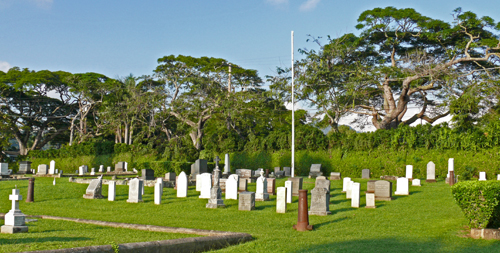Cephas fought in the Spanish-American War in Cuba and the Philippine Islands. He was part of the enlistment plan of the U.S. Government to recruit black soldiers for this effort, under the belief that they were immune to tropical diseases. These soldiers were called "the immunes." He was in the 25th infantry.
His experiences as a black soldier were chronicled in letters he sent back to the hometown newspaper, and are widely quoted in several books on that historic period.
Monthly army reports from the war in the Philippines show Cephas was excused from action due to illness from 1899 through 1901, when he was removed from service and returned to the United States on a hospital ship, then discharged with invalid status at the Presidio in San Francisco.
He lived in various national military homes for disabled veterans, in Ohio and California, from 1902 through 1929, when he moved to Honolulu. It's likely the hospital ship had stopped in Hawaii on the way back to California; he had no family there.
His passionate testimony is seen in records of hearings on the establishment of a Home for Disabled Veterans in Hawaii, for which he was a strong advocate. He passed away at the age of 84 in 1947. The first veterans home was finally opened in Hawaii in 2007.
Initially he was buried on September 15, 1947 at Diamond Head Memorial Park in Sec. F-41-O without a stone. The Veterans Administration paid for the burial.
On May 21, 1955, his remains were disinterred and reburied in the Grand Army of the Republic plot at O`ahu Cemetery, under the auspices of the Veterans of Foreign Wars, with a proper gravestone. A note in the cemetery log reads, "Only his bones were interred."
For someone whose life took him ever to new horizons, never settling in one place for long, the fact of his two burials seems ironically fitting.
Cephas fought in the Spanish-American War in Cuba and the Philippine Islands. He was part of the enlistment plan of the U.S. Government to recruit black soldiers for this effort, under the belief that they were immune to tropical diseases. These soldiers were called "the immunes." He was in the 25th infantry.
His experiences as a black soldier were chronicled in letters he sent back to the hometown newspaper, and are widely quoted in several books on that historic period.
Monthly army reports from the war in the Philippines show Cephas was excused from action due to illness from 1899 through 1901, when he was removed from service and returned to the United States on a hospital ship, then discharged with invalid status at the Presidio in San Francisco.
He lived in various national military homes for disabled veterans, in Ohio and California, from 1902 through 1929, when he moved to Honolulu. It's likely the hospital ship had stopped in Hawaii on the way back to California; he had no family there.
His passionate testimony is seen in records of hearings on the establishment of a Home for Disabled Veterans in Hawaii, for which he was a strong advocate. He passed away at the age of 84 in 1947. The first veterans home was finally opened in Hawaii in 2007.
Initially he was buried on September 15, 1947 at Diamond Head Memorial Park in Sec. F-41-O without a stone. The Veterans Administration paid for the burial.
On May 21, 1955, his remains were disinterred and reburied in the Grand Army of the Republic plot at O`ahu Cemetery, under the auspices of the Veterans of Foreign Wars, with a proper gravestone. A note in the cemetery log reads, "Only his bones were interred."
For someone whose life took him ever to new horizons, never settling in one place for long, the fact of his two burials seems ironically fitting.
Gravesite Details
Buried: 1947-09-15
Sponsored by Ancestry
Advertisement
Explore more
Sponsored by Ancestry
Advertisement



